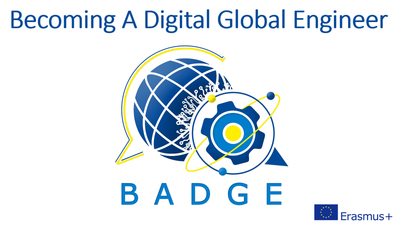BADGE – Becoming a Digital Global Engineer

Intellectual Output
BADGE – Becoming a Digital Global Engineer
Project 2019-1-FR01-KA203-063010 (167 512 512)

BADGE – Becoming a Digital Global Engineer
Project 2019-1-FR01-KA203-063010 (167 512 512)

After studying this unit, you will be able to …

We live in the era of digitalization. Have you ever wondered how this influences the amount of data we generate daily? With around 4.66 billion active internet users worldwide (2020/ 2021), compared to just 2.6 billion in 2013, 2.5 quintillion bytes of data are generated each day.
........................
Modern civilization has become so developed and sophisticated that to survive you have to be competitive. By comparing and contrasting you can identify your position as either a winner or a loser, as either better, worse, or somewhere in the middle. To compete with other trends, we need a vast amount of data. A huge collection of data from various sources not only fills the information gap, but also gives us an apparent feeling of being able to control the world, as well as an awareness and knowledge about our environment.
........................
Data is the name given to “raw material”, i.e. anything that is or can be processed mentally or by any computing machine. This "processability", that is, the possibility of using data further, is one of the main purposes of data collection. Thus, by definition, data are plain facts or figures collected together for analysis, reference and interpretation.
Data can be used not only in an abstract context, but also in all areas of life since huge amounts of information are assimilated and then analyzed for development, market analysis, financial predictions, insights into human behavior and reactions, etc.
........................
Although the words data and informationseem very much alike, there are lots of differences between these two. As already mentioned, data are plain facts, but when these facts are processed, organized, structured or presented in a given context so as to make them useful, they become information. Thus, it is not enough to simply collect data, as without processing, they are fairly useless. It is analysis and interpretation which makes them meaningful. Information is data that has been converted into a more useful or intelligible form for utilization. It may be noted that information may be further processed and/or manipulated to form knowledge, which is defined as information containing wisdom.
........................
The difference between data and information has now been defined, so let us consider data presentation.
Effective data presentation is nothing more than the provision of information in a way that it can be understood, sometimes remembered, and most importantly, analyzed, processed and interpreted by the audience.
The
presentation of theories, hypotheses or theses seems relatively easy compared with presenting numbers, statistics and hard data. How can we make numbers, statistics and hard data interesting or even surprising for our audience? How can we inspire our audience to analyze the data and, consequently, encourage them to formulate new theories contributing to the development of knowledge?
Dealing with data effectively
Ingredients for cooking the final “dish”:
data collected, context, computer, logical and analytical thinking, purpose of the presentation (audience), and patience.
Data presentation needs to have a precise purpose, therefore it should be related to a specific context and prepared for a specific audience. Providing a context helps the audience visualize and understand the numbers.
Collected data should be processed in a way that is comprehensible to an audience.
The design of visuals ought to be readable and clear. Ensure your audience understand at a glance what your data represent, but at the same time keep them sufficiently vague so that they pay attention to your speech for more information.
Logical and analytical thinking should be the starting point of data interpretation.
Keep it simple – when it comes to making data digestible, simplicity, neat positioning and clever formatting are key.
Use text wisely and sparingly. Text plays a vital role in data presentation so it should be used strategically. Keep text to a minimum and as a supporting element.